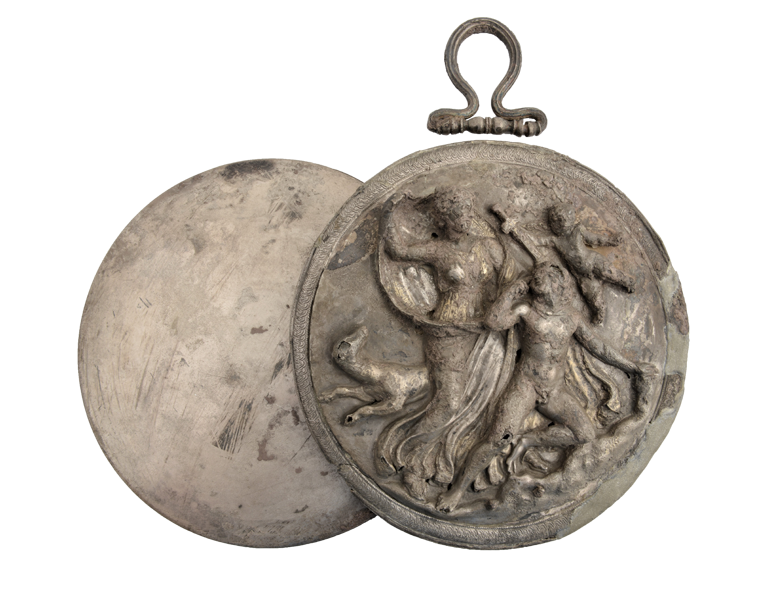Exhibit of the month
Gods in love, sublime mortals …
«… απόλλυμαι γε υπό του έρωτος.»
“… I am dying of love, that’s all”
Lucian, Dialogues of the Gods, 11 (Aphrodite and Selene)
Silver folding mirror with relief decoration and traces of gilding
National Archaeological Museum
Collection of Metalwork, inv. no X16111
Provenance: found in the cemetery of ancient Demetrias in Magnesia, Thessaly.
Dimensions: Diameter: 0.17 m
Date: early 3rd c. BC.
Location of object within the exhibition: Metalwork Collection, Room 38, Showcase 57.
The cover of the mirror is decorated with a representation of Selene with her beloved Endymion. According to the myth, the amorous adventures of Selene were numerous. Following her union with Helios and Aer she gave birth to the Horae and Drosos respectively. Yet, her greatest infatuation was the “exceedingly beautiful” (“πάνυ καλός”) Endymion[1], a hunter and a shepherd that was granted, according to an account, everlasting youth by Zeus who put him into eternal sleep, thus fulfilling Selene’s request. Selene then visited him every night while he was sleeping in a cave on Mount Latmos at Karia in Asia Minor. From the union of the goddess with the mortal fifty daughters were born.
In the relief representation of the mirror, Selene is depicted rushing towards the youth. She is dressed in sleeveless chiton and rich himation that billows intensely around her (velificatio), a characteristic element in the iconography of the goddess. Her vigorous movement is indicated by the diagonal pleats of her himation that flows between her legs. With her right hand she keeps her himation in place over her head, while she puts her left hand around the youth’s neck in order to seduce him.
Endymion is shown beardless, shapely and well-built, almost totally naked, with the exception of a chlamys tied around his neck that falls over his back, waking up startled, as he lies on the rocky ground of his cave. He turns his gaze towards the goddess in awe and does not resist her as he seems ready to satisfy her lust. Behind Selene stands Endymion’s hound which moves away unwilling to protect its master from the “aggressive” goddess. Over the youth’s head flies Eros proffering to Selene Endymion’s sword in its scabbard. The weapon held in Eros’ hands denotes that the desire which overwhelms the heart of gods and mortals resembles the wounds caused by a sword.
The scene on the mirror from Demetrias is one of the earliest representations of the visit of Selene to Endymion that date back to the Hellenistic period. The theme becomes particularly popular in Roman art and its iconography is established showing the erotically disposed Selene approaching Endymion during his sleep.
The Greek mythology abounds with examples of gods that couple with mortals. Zeus leads the way with countless mortal lovers. Aphrodite mated with the mortals Adonis and Anchises. Eos pursued many handsome youths, such as Cephalus and Tithonus. Boreas abducted Oreithyia, daughter of the king of Athens Erechtheus, and took her to his homeland Thrace.
Even gods seem defenceless before the beauty of the mortals and, struck by Eros’ arrows, pursue their object of desire which rarely manages to escape from them.
Alexandra Chatzipanagiotou
[1] the «πάνυ καλός/ superbly beautiful» Endymion
The «acclaimed beauty» of Endymion inspired the poet Constantine Cavafy, who wrote the poem «Before the Statue of Endymion»:
I’ve come from Miletos to Latmos
on a white chariot drawn by four snow-white mules,
all their trappings silver.
I sailed from Alexandria in a purple trireme
to perform secret rites-
sacrifices and libations- in honour of Endymion.
And here is the statue. I now stare
at Endymion’s famous beauty in wonder.
My slaves empty baskets of jasmine
and auspicious tributes revive the pleasure of ancient days.
(From the Poems 1897-1933)
ΠΗΓΗ: http://www.kavafis.gr/poems/content.asp?id=103&cat=1
Selected Bibliography:
Α. Αρβανιτόπουλος, «Αργυρούν κάτοπτρον Δημητριάδος· Σελήνη και Ενδυμίων», Πολέμων Ι (1929), 7-27.
Καράγιωργα-Σταθακοπούλου, Θ., «Αρτέμιδος Φίλος», ΑΔ 54 (1999), Α΄ Μελέτες, 134-135, pl. 19b.
LIMC II (1984), s.v. Astra, 914, no. 55, pls 678, 55 (S. Karusu).
LIMC III (1986), s.v. Endymion, 729, no. 13 (Η.Gabelman).
Schefold, K., Die Göttersage in der klassischen und hellenistischen Kunst, München 1981, 294, fig. 428.
Schwarzmaier, A., Griechische Klappspiegel: Untersuchungen zu Typologie und Stil, Berlin 1997, 12, 15, 52, 119-120, 213, 249, cat. no. 35, pl. 50.1.
Strong, D. E., Greek and Roman Gold and Silver Plate, London 1966,104, pl. 29 A.
Züchner, W., Griechische Klappspiegel, Berlin 1942, KS 88, 63, 124, 135, 173-174.


